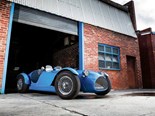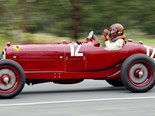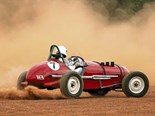Ford Speedster: Edsel Ford's Hot Rod
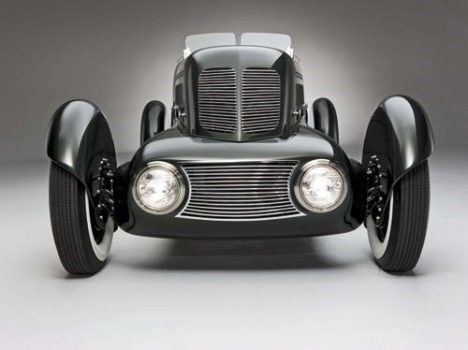 Ford Speedster: Edsel Ford's Hot Rod
Ford Speedster: Edsel Ford's Hot Rod

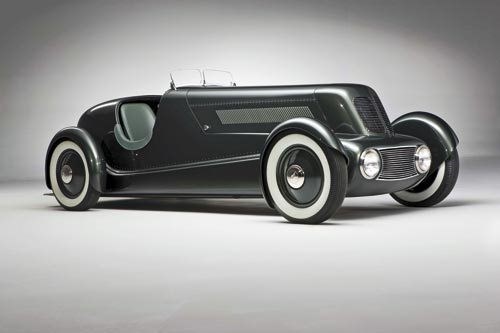 Ford Speedster: Based on a 1934 Ford Model 40 chassis
Ford Speedster: Based on a 1934 Ford Model 40 chassis

 Ford Speedster: Based on a 1934 Ford Model 40 chassis
Ford Speedster: Based on a 1934 Ford Model 40 chassis
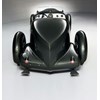
 Ford Speedster: Based on a 1934 Ford Model 40 chassis
Ford Speedster: Based on a 1934 Ford Model 40 chassis

 Ford Speedster dash: machine-turned finish & Lincoln instrumentation
Ford Speedster dash: machine-turned finish & Lincoln instrumentation
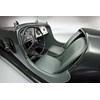
 Ford Speedster: Dash was updated during a 1939 redesign
Ford Speedster: Dash was updated during a 1939 redesign

 Ford Speedster: stock Ford flathead V8
Ford Speedster: stock Ford flathead V8
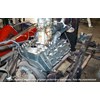
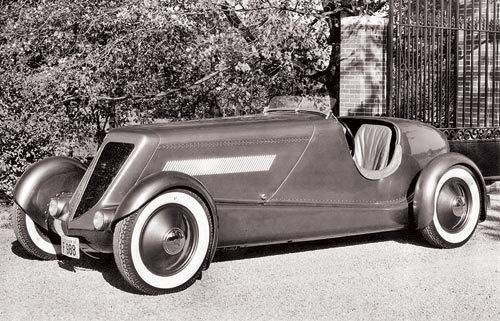 Period shot showing original vee-shape radiator grilles
Period shot showing original vee-shape radiator grilles

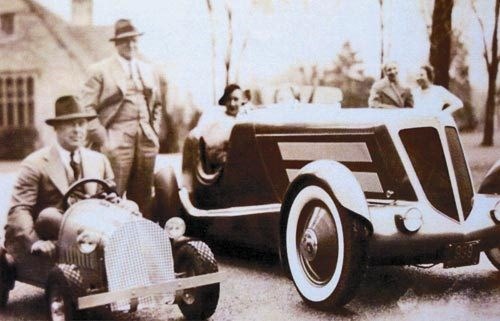 Ford Speedster: Edsel Ford's Hot Rod
Ford Speedster: Edsel Ford's Hot Rod

 Ford Speedster: Edsel Ford's Hot Rod
Ford Speedster: Edsel Ford's Hot Rod
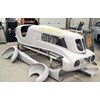
 Edsel Ford
Edsel Ford

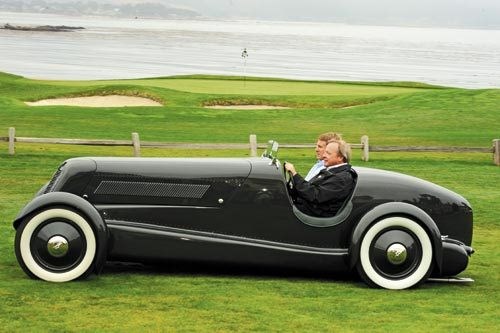 Ford Speedster at Pebble Beach
Ford Speedster at Pebble Beach

![UNC_353_Ford_Henry_Edsel[1].jpg](http://assets.primecreative.com.au/imagegen/cp/black/800/600/assets/TradeUniqueCars/GalleryMedia/UNC_353_Ford_Henry_Edsel_1_.jpg)
![UNC_353_Ford_Henry_Edsel[1].jpg](http://assets.primecreative.com.au/imagegen/max/c/100/100/assets/TradeUniqueCars/GalleryMedia/UNC_353_Ford_Henry_Edsel_1_.jpg)

|
|
Ford Speedster: Edsel Ford's Hot Rod
|

|
|
Ford Speedster: Based on a 1934 Ford Model 40 chassis
|

|
|
Ford Speedster: Based on a 1934 Ford Model 40 chassis
|

|
|
Ford Speedster: Based on a 1934 Ford Model 40 chassis
|

|
|
Ford Speedster dash: machine-turned finish & Lincoln instrumentation
|

|
|
Ford Speedster: Dash was updated during a 1939 redesign
|

|
|
Ford Speedster: stock Ford flathead V8
|

|
|
Period shot showing original vee-shape radiator grilles
|

|
|
Ford Speedster: Edsel Ford's Hot Rod
|

|
|
Ford Speedster: Edsel Ford's Hot Rod
|

|
|
Edsel Ford
|

|
|
Ford Speedster at Pebble Beach
|
![UNC_353_Ford_Henry_Edsel[1].jpg](http://assets.primecreative.com.au/imagegen/max/c/100/100/assets/TradeUniqueCars/GalleryMedia/UNC_353_Ford_Henry_Edsel_1_.jpg)
|
Edsel Ford had a penchant for sports cars and a keen eye for design, as his beautiful custom speedster illustrates

|
|
Ford Speedster: Edsel Ford's Hot Rod
|
Ford Speedster
EDSEL'S TOY
To motoring enthusiasts the world over, the name Edsel is synonymous with the failed Ford model of the same name, built from 1958 to 1960. To be sold through the newly formed Edsel division of the Ford Motor Co., this all-new car became a marketing disaster that eventually cost the company US$400 million.
The Edsel was named after Henry Ford’s only child, who became President of the Ford Motor Company in 1919, remaining so until his untimely death in 1943, aged just 49. Despite being posthumously associated with the ill-fated project, Edsel Ford is recognised as having made a significant contribution to the design direction of the Ford Motor Company before his death.
Unlike his father, Edsel had a penchant for sports cars, indulging his passion with the purchase of the first MG to be imported into the United States. Following a trip to Europe in 1932, the younger Ford had an aluminium boat-tailed speedster custom designed by the company’s chief designer E. T. (Bob) Gregorie.
Featuring Ford’s new low-cost V8 engine, it contained many unusual features, but in Edsel’s eyes wasn’t low or sporty enough, so two years later he had the same designer pen and supervise the build of a new alloy-bodied speedster, a striking sportster built off a lowered 1934 Ford Model 40 chassis frame. Despite the almost standard 2870mm wheelbase of a 1934 Ford roadster, the speedster gave the impression of being longer and lower by having its cockpit located towards the rear and by extending the tail section.
This unique piece of Ford motoring history has intrigued enthusiasts for nearly eight decades and its discovery, restoration and subsequent appearance at the 2011 Pebble Beach Concours in the hands of Edsel Ford’s grandson, Edsel Ford II, created enormous interest.
Superbly restored by RM Auto Restorations in Ontario, Canada, the Speedster is now resplendent in its original colours of Pearl Essence Gunmetal Dark paintwork with matching grey leather trim.
"My grandfather was an early believer that everyday objects, including automobiles, could be seen as works of art," said Edsel Ford II at the Speedster’s unveiling. "While he wasn’t a designer in the traditional sense, his eye for styling and influence was apparent as he initiated the design department at Ford Motor Company."
Edsel Ford and Bob Gregorie were a formidable styling team from the mid-1930s and the duo would go on to create production cars like the 1936 Lincoln Zephyr and the 1941 Lincoln Continental Cabriolet, the latter described by the celebrated architect, Frank Lloyd Wright, as "the most beautiful car in the world".
The duo guided the overall style of the Ford Motor Co. and according to Gregorie in a 1985 interview it was a truly collaborative effort: "Even though there were two of us, we thought as one. My hands became Edsel’s tools in developing designs. I was able to put on paper and into clay the designs he was visualising in his head."
The Speedster’s body design was fabricated by Gregorie and the supervisor at the Lincoln Plant, Robbie Robinson. The pair was assisted by personnel from the Ford Aircraft Division who fabricated a taper-tailed aluminium body with cut-down door openings. The bodywork followed best aircraft practice – light yet very strong. The 950kg Speedster is powered by a stock Ford flathead V8 with a dual exhaust system enclosed in the bodywork with only the exhaust tips protruding.
The instrument panel, with its machine-turned finish, housed standard Lincoln instrumentation and a simple starter button. Visually, the speedster originally featured a pair of narrow vee-ed radiator grilles with a single row of side louvres in each of the bonnet sides. Cooling was minimal, though, and the car had a tendency to overheat.
By 1939 Gregorie had redesigned the front end, reducing the height of the upper radiator grilles and fabricating a new wide horizontal grille for improved cooling, the surround of which also encompassed the two driving lights. Completed in 1940, the changes also included an upgraded instrument panel featuring a 160mph speedometer and matching Stewart-Warner accessory instruments. A winter freeze in 1939-40 cracked the engine block and a new, more powerful Mercury V8 was subsequently installed.
Ford historians suggest Edsel only enjoyed the Speedster for a few years before his death in 1943, at which point it was bequeathed to his widow, Eleanor, valued at just $200. In 1944 the Speedster was sold and while en-route to Miami was sold again to a buyer in Atlanta for $1000. By 1947 it had found its way to Los Angeles where it was hidden in storage.
A year later, the following advertisement appeared in Road and Track magazine: "Especially constructed Ford Chassis. Aluminium body built by Edsel Ford. Now powered by a special Mercury engine. Priced reasonably at $2500. Coachcraft Ltd. Melrose Ave."
By 1952 it appeared in Auto Sport Review, photographed in Hollywood with an up and coming actress named Lynn Bari. In 1957 it was transported back to Georgia and a year later sold to a U.S. sailor in Florida for $603. By this time it showed 19,000 miles on the odo and had been painted red with red leather.
The sailor partially dismantled the engine for a rebuild but shortly after shipped out to Vietnam. By the time he returned home the engine had seized. Nearly 40 years elapsed until 1999 when Bill Warner, the founder of the Amelia Island Concours d’Elegance, rescued the Speedster from the sailor’s garage.
Warner touched up the paint and rebuilt the engine before selling the Speedster to the celebrated Texas lawyer John O’Quinn in 2008 for US$1.76 million. Following O’Quinn’s untimely death in a road accident in 2009, Edsel Ford II arranged for the Speedster’s purchase for permanent display at the Edsel and Eleanor Ford Estate at Gaukler Point in Grosse Point Shores, Michigan.
The decision was taken to restore the car to its 1940 configuration with modified cooling. Despite this, the Speedster overheated after a prolonged wait to drive over the presentation ramp at Pebble Beach.
RM Auto Restorations reports that in restoring the major mechanical componentry the chassis was found to be custom-built. Two additional cross members in the front enabled the engine to be mounted rearward and the chassis is considerably stiffened with additional gussets and plates.
With the body fully stripped to bare metal the modifications undertaken in 1940 were clearly evident. The Speedster continues to form part of the historic Edsel and Eleanor Ford House in Grosse Points Shores, Michigan.
EDSELL’S LEGACY
At times at odds with his father, Henry, Edsel had long stressed the importance of a replacement model for the ageing Model T. By 1927 the need for a new model was inevitable and Henry left the body design of the new model to his son who had far more interest in automotive styling.
He also encouraged his father to introduce four-wheel brakes and a sliding-gear transmission on the Model A, which would became a huge commercial success over four years of production.
He was also a strong advocate of modern design elements, such as the introduction of hydraulic brakes.
*****
Search used:
>> Search Ford roadsters for sale
Unique Cars magazine Value Guides
Sell your car for free right here
Get your monthly fix of news, reviews and stories on the greatest cars and minds in the automotive world.
Subscribe

.jpg)







